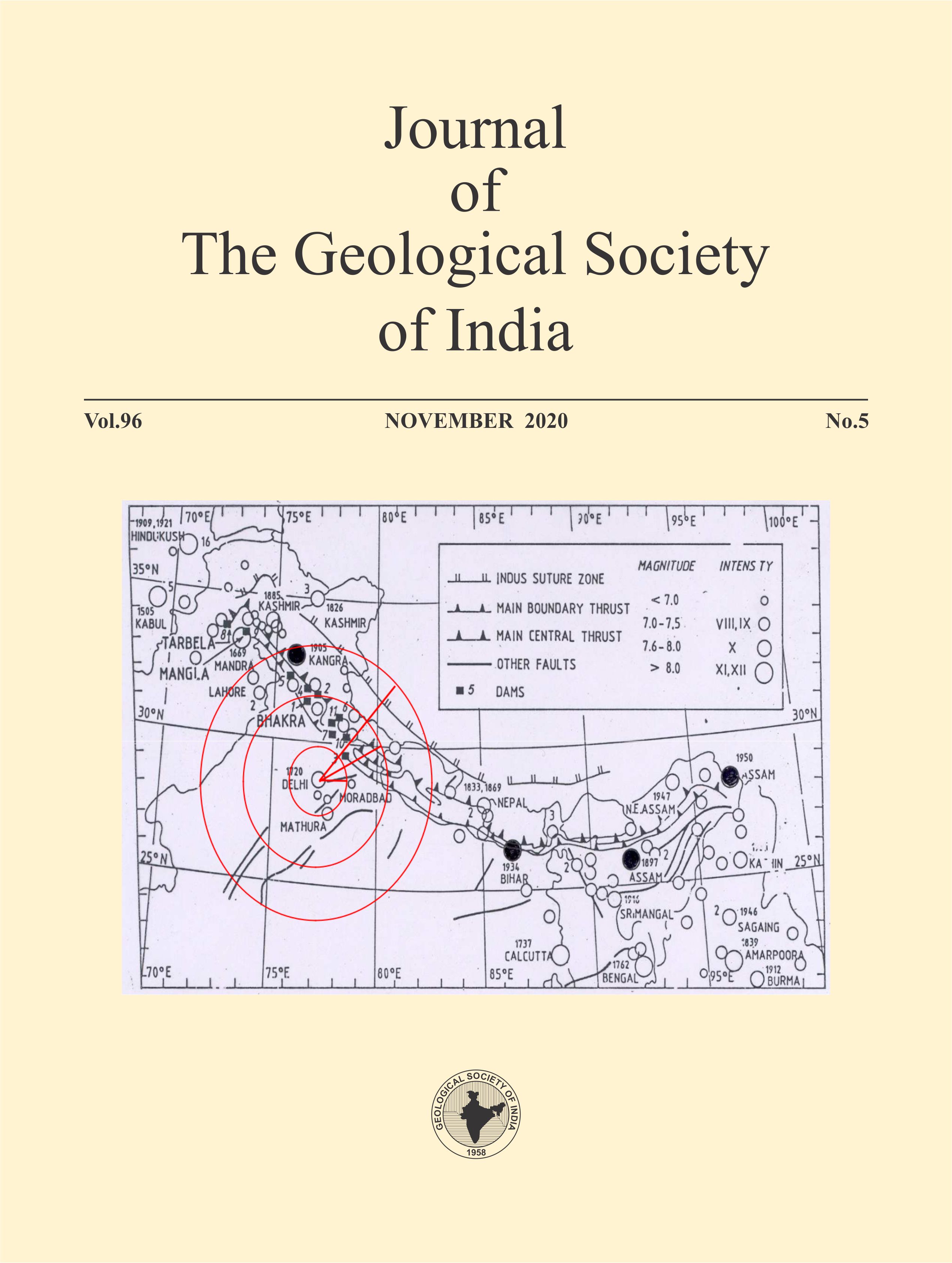A GIS-based Methodology for Assigning a Flux Boundary to a Numerical Groundwater Flow Model and Its Effect on Model Calibration
DOI:
https://doi.org/10.1007/s12594-020-1589-7Abstract
Groundwater flow modeling is an important tool for understanding and computing hydrology and water availability of an aquifer zone. However, an accurate representation of boundaries and their initial conditions are vital for simulation of the groundwater flow phenomena. In this study, efforts have been made to develop a GIS based methodology for estimating flux across boundaries of the study area using Darcy flow tool. The spatial maps of topography, bore log, transmissivity, hydraulic conductivity, porosity and groundwater levels for the study area were created in ArcGIS 9.3.1 using krigging method. A buffer zone of 1í—1 km2 cell size was created on inner and outer side of the boundaries and Darcy flow model was used to estimate specified flux across boundaries. The groundwater behavior of the study area was simulated with specified flux boundary condition (Neumann boundary condition) and no flow boundary condition to assess importance and estimation accuracy of estimated flux. Darcy model output indicates that flux across the boundaries contributed about 36.20 mm in average annual change in groundwater table depth. With estimated specified flux, simulation accuracy of groundwater flow model (R2) increased to 0.97 from 0.90. The satisfactory level (R2=0.97) of simulation accuracy reveals that developed methodology can be used for estimating flux across boundaries in the absence of physical boundaries.Downloads
Metrics
Issue
Section
Downloads
Published
How to Cite
References
Ajami, H., Meixner, T., Hogan, III. J.F. and Guertin, D.P. (2011) Impact of land-surface elevation and riparian evapotranspiration seasonality on groundwater budget in MODFLOW models. Hydrogeol. Jour., v.19, pp.1181-1188.
Allen, R.G., Pereira, L.S., Raes, D. and Smith, M. (1998) Crop evapotranspiration: guidelines for computing crop requirements. FAO Irrigation and Drainage Paper No.56. FAO, Rome, Italy.
Anon (2000) Visual MODFLOW V.2.8.2 User's manual for professional applications in three-dimensional groundwater flow and contaminant transport modeling. Waterloo Hydrogeologic Inc., Ontario.
Anonyms (2003) World Water Assessment Program. The United Nations World Water Development Report, UNESCO, Paris and Berghahn.
Bouwer, H. (2000) Integrated water management: emerging issues and challenges. Agric Water Managmt., v.45(3), pp.217–228.
CGWB (2006) Dynamic Groundwater Resources of India. Central Ground Water Board Report (CGWB), Ministry of Water Resources, New Delhi, India.
Diersch, H.J.G. (2005) WASY software FEFLOW user's manual for finite element subsurface flow and transport simulation system, Berlin, Germany.
Dujardin, J., Anibas, C., Bronders, J., Jamin, P., Hamonts, K., Dejonghe, W., Brouyère, S., and Batelaan, O. (2014) Combining flux estimation techniques to improve characterization of groundwater–surface-water interaction in the Zenne River, Belgium. Hydrogeol. Jour., v.22, pp.1657– 1668.
Franke, O.L., Reilly, T.E. and Bennett, G.D. (1987) Bennett definition of boundary and initial conditions in the analysis of saturated ground-water flow systems an introduction. U.S. Govt. Print. Off.
Harbaugh, A.W., Banta, E.R., Hill, M.C. and McDonald, M.G. (2000) MODFLOW-2000, the U.S. Geological Survey modular groundwater model: User guide to modularization concepts and Groundwater flow Process. U.S. Govt. Print. Off.
Harbaugh, A.W. (2005) MODFLOW-2005, the U.S. Geological Survey modular ground-water model - the Ground-Water Flow Process. U.S. Govt. Print. Off.
Kaur, S., Aggarwal, R., Jalota, S.K., and Sood, A. (2015) Estimation of fluxes across boundaries for groundwater flow model using GIS. Curr. Sci, v.109(3), pp.607-610.
Khadri, S.F.R. and Pande, C. (2016) Ground water flow modeling for calibrating steady state using MODFLOW software: a case study of Mahesh River basin, India. Modeling Earth Systems and Environ., v.2(39), pp.1-17.
Konikow, L.F. and Bredehoeft, J.D. (1978) Computer Model of TwoDimensional Solute Transport and Dispersion in Ground Water. U.S. Govt. Print. Off.
Kushwaha, K. and Goyal, R. (2016) Methodology for the estimation of groundwater flux across simplified boundary using GIS and groundwater levels. Curr. Sci., v.110(6), pp.1050-1058.
McDonald, M.G. and Harbaugh, A.W. (1988) A modular three-dimensional finite-difference groundwater flow model. U.S. Govt. Print. Off.
Moustadraf, J., Razack, M. and Sinan, M. (2008) Evaluation of the impacts of climate changes on the coastal Chaouia aquifer, Morocco, using numerical modeling. Hydrogeol. Jour., v.16, pp.1411-1426.
Narjary, B., Kumar, S., Kamra, S.K., Bundela, D.S., Sharma, D.K. (2014) Impact of rainfall variability on groundwater resources and opportunities of artificial recharge structure to reduce its exploitation in fresh groundwater zones of Haryana. Curr. Sci., v.107, pp.1305-1312.
Nayak, P.C., Vijaya Kumar, S.V. and Rao, P.R.S. (2017) Recharge source identification using isotope analysis and groundwater flow modeling for Puri city in India. Appl. Water Sci., v.7,pp.3583–3598.
Patle, G.T., Singh, D.K., Sarangi, A., Rai, A., Khanna, M. and Sahoo, R.N. (2015) Time series analysis of groundwater levels and projection of future trend. Jour. Geol. Soc. India, v.85, pp.232-242.
Rao, S.V.N., Kumar, S., Shekhar, S., Sinha, S.K. and Manju, S. (2007) Optimal pumping from skimming wells from the Yamuna River flood plain in north India. Hydrogeol. Jour., v.15(6), pp.1157-1167.
Reilly, T.E. (2001) System and Boundary Conceptualization in Ground-water Flow Simulation. U.S. Govt. Print. Off.
Shekhar, S. and Rao, S.V.N. (2011) Groundwater Management in Palla Well Field of Delhi Using Numerical Modeling Technique – A Case Study. Bhu-Jal News, v.25(3&4) and 26 (1&4), pp.46-51.
Singh, O. and Kasana, A. (2017) GIS-based spatial and temporal investigation of groundwater level fluctuations under rice-wheat ecosystem over Haryana. Jour. Geol. Soc. India, v.89, pp.554–562.
Singhal, V. and Goyal, R. (2011) Development of conceptual groundwater flow model for Pali Area. India. Afr. Jour. Environ. Sci. Techn., v.5(12), pp.1085–1092.
Singhal, V. and Goyal, R. (2011)GIS based methodology for groundwater flow estimation across the boundary of the study area in groundwater flow modeling. Jour. Water Res. and Prot., v.3, pp.824-831.
Tomar, V., Kamra, S.K., Kumar, S., Kumar, Ajay and Khajuria, V. (2012) Hydro-chemical analysis and evaluation of groundwater quality for irrigation in Karnal district of Haryana state, India. Intern. Jour. Environ. Sci., v.3(2), pp.756-766.
Wada, Y., Van, Beek, L.P.H., Van Kempen, C.M., Reckman, J.W. T.M., Vasak, S. and Bierkens, M.F.P. (2010) Global depletion of groundwater resources. Geophys. Res. Lett., v.37(L20402), pp.1-5.
Zijl, W., El-Rawy, M. and Batelaan, O. (2013) Modeling Groundwater Flow using Neumann and Dirichlet Boundary Conditions. Geophys. Res. Abst., v.15, pp.1-1.

 Satyendra Kumar
Satyendra Kumar






